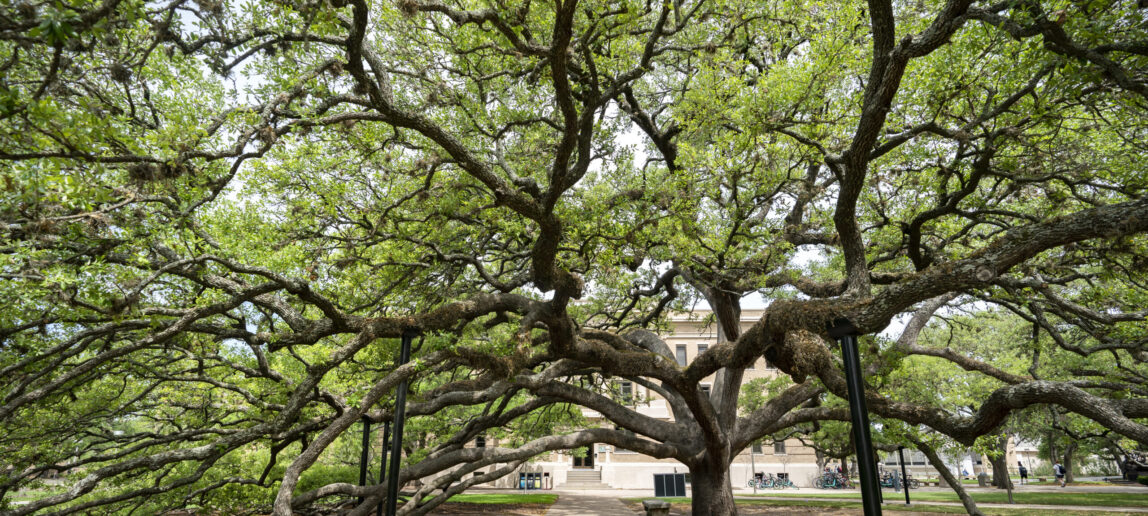Texas A&M’s Century Tree Gets New Life Through Successful Cloning
A new chapter in Texas A&M University’s history has begun with the successful cloning of the iconic Century Tree. This live oak has long stood as a symbol of strength, stability and enduring tradition on campus.
The project, conceived through a collaboration between university staff and industry experts, aims to preserve and protect the legacy of the beloved tree, known for its centuries-old presence near the Academic Building.
How it started
The project, which resulted in more than 40 successfully rooted clones, began as a conversation at the Texas ASLA Conference in Austin between Dr. Galen Newman, head and professor in the Department of Landscape Architecture and Urban Planning at Texas A&M, and Chris Shipley, president and co-owner of Civano Growers. Shipley shared that his company—a leader in the cloning industry—had the technology to replicate the historic oak tree.
“We felt it was a necessary undertaking to clone the Century Tree based primarily on its cultural and historic significance at Texas A&M,” Newman said. “It is a landmark and an iconic symbol of the campus. Considering its age, we wanted to be able to go ahead and put in motion some possible replacements for the tree early, should something ever happen to it, and one that would preserve the tree’s genetic heritage as closely as possible. We know how much Aggies love the Century Tree, and we hope to allow them to continue to enjoy it for generations to come.”
He said the project quickly evolved into a collaborative effort involving several colleagues: Chanam Lee from the Department of Landscape Architecture and Urban Planning, Mike Arnold from the Department of Horticultural Sciences, and Scott Shafer, executive director of campus and community enrichment in the Department of Hospitality, Hotel Management and Tourism.
“Together, we partnered with the Civano Growers team, including Chris Shipley and Stephanie Vickers,” Newman said.
Shafer served as the project’s liaison to senior university leadership, working over several weeks to engage various departments and ultimately secure approval from the President’s Office.
Once the idea was approved, Arnold oversaw the collection of the cuttings, detailing the meticulous process. He harvested the cuttings from areas of the tree with juvenile growth characteristics, ensuring the tissues were hydrated and carefully handled.
The cuttings were placed in sealed bags with water to maintain high humidity levels during transport. They were then carefully shipped to Civano Growers in insulated boxes for cloning.
“Normally, only two to four cuttings might successfully root out of 200,” Arnold said. “The fact that over 40 are rooted is really exciting and beyond our expectations.”

Nick Shipley, chief operations officer and co-owner of Civano Growers, said he is passionate about preserving large, beautiful heritage trees for future generations to appreciate.
“When I heard about the Century Tree on the Texas A&M campus, I saw it as a fun challenge and an opportunity to apply my skills to preserve the genetics of this significant, beloved and historic live oak tree,” said Nick Shipley.
He added, “I firmly believe in selecting the best plant genetics to ensure that they thrive in our urban environment. The Century Tree serves as a prime example of this philosophy. While most urban trees have short and unproductive lives, the Century Tree stands out as an exceptional representative of its species, with a rich history that deserves to be preserved for future generations.”
Next plans
Future plans being discussed for the Century Tree saplings include planting a few on campus as backups for the original tree, with others potentially being placed around campus and in nearby parks such as Schob Nature Preserve,—a shared space between the Department of Landscape Architecture and Urban Planning (LAUP) in the College of Architecture and the Department of Recreation, Park and Tourism Sciences (RPTS) in the College of Agriculture and Life Sciences.
The successful cloning of the Century Tree marks a significant step in preserving Texas A&M University’s rich heritage. The project not only ensures the future of a beloved campus symbol, but also highlights the power of innovation through collaboration between academic experts and industry leaders.
Aggie culture
Texas A&M University’s Century Tree has become a legendary symbol of love and tradition for generations of Aggies.
Located near the Academic Building, the sprawling live oak is more than 100 years old and was among the first trees planted on the university’s 5,200-acre campus. Its massive, drooping branches make it a popular spot for photos, proposals and weddings.
According to tradition, couples who walk under the Century Tree will eventually marry. If a proposal takes place beneath its branches, it is said the marriage will last forever.
Learn more about Aggie culture and traditions here.


